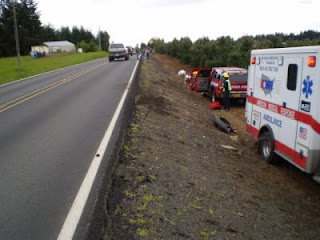Swerve and Survive

Two motorcycles crashed today in an unlikely accident that illustrates the critical need for refresher training.
A 2001 BMW K1200LT motorcycle, with a 54 year old operator and a 54 year old passenger, came upon a bucket that had blown out from the back of a pickup onto the roadway. The operator successfully swerved and missed the bucket.
A 2003 BMW R1150T motorcycle, with a 61 year old operator and a 60 year old passenger, was traveling some distance behind the first motorcycle, although they were not traveling together. The second motorcycle's operator attemted to swerve around the bucket but crashed into the back of the first motorcycle.
All four riders were transported to a nearby hospital. The first motorcycle's operator and passenger sustained minor injuries. The second motorcycle's operator sustained serious injuries, and the passenger critical injuries. All four riders were wearing helmets.
Lessons Learned
1. Refresher TrainingSwerving at highway speeds is an advanced level of motorcycling skill. It must be deliberately learned and practiced, and it should be part of a yearly refresher training or drill. It is NOT a natural technique, yet it is critically important for surviving on a motorcycle.
Find an empty parking lot or rural road and practice swerving to avoid a hazard. The key is to push hard to one side of the handlebars and immediately push hard on the other side. Keep your feet firmly on the footboards and let your butt slide slightly from side to side as the bike leans first one way, and then the next.
The swerve feels insecure to most new riders. You must trust your tires to grip the road, and you must accept the lean of your bike.
How many times, do you suppose, did these motorcyclists practice swerving? When was the last you YOU practiced a swerve?
2. Following Distance
This accident was caused first and foremost by lack of awareness and lack of adequate following distance. The second motorcyle should have had more distance between them and the first bike. This would allow them to see the first bike suddenly swerve, alerting them to the need to slow down and prepare evasive action themselves.
I put no blame on the first motorcyclist. A bucket blown off a truck could quickly enter the path of the motorcycle. But the operator had the presence of mind, the alertness, and the skill to successfully avoid contact. The first bike would have escaped all injury except for the inattention and lack of skill of the second motorcylist.
Save your life, and that of other motorcyclists on the same road as you: attend motorcycle refresher training every year!
Reference Links
http://pdxtraffic.blogspot.comhttp://www.ktvz.com




